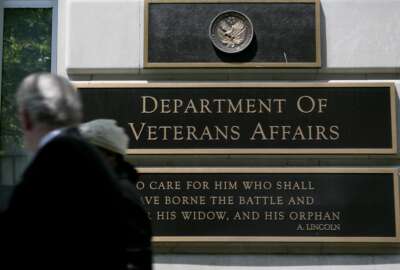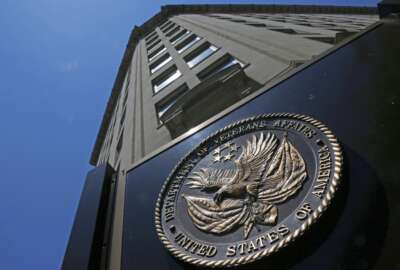
VA on-track to hire 52K health care workers in FY 2023 to handle more vets seeking care
The Department of Veterans Affairs is more than halfway to meeting its hiring goal for health care workers this fiscal year, and ahead of schedule to achieve it...
The Department of Veterans Affairs is more than halfway to meeting its hiring goal for health care workers this fiscal year, and ahead of schedule to achieve its workforce goals this fall.
The Veterans Health Administration is looking to hire 52,000 employees before the end of fiscal 2023. That hiring goal accounts for replacing staff lost through attrition, as well as increased demand for health care workers under the Promise to Address Comprehensive Toxics (PACT) Act.
VA Undersecretary for Health Shereef Elnahal told reporters Thursday that VHA meeting its hiring goal would result in a 3% increase in the number of health care employees onboard at the agency. Elnahal said that, so far in the fiscal year, VHA has seen a 1.5% increase in the number of employees brought on board.
“That’s in less than half of the year, and so I’m optimistic that we’ll hopefully meet that goal. But challenges abound with hiring for every single health care system, so we’re not complacent at all,” Elnahal said. “We’re continuing to make the changes we need to make the hiring process faster and better to be able to meet the mission.”
While VHA is ahead of schedule with its hiring goals, Elnahal said the agency hits moments throughout the year where applications for health care workers “wax and wane seasonally.”
The PACT Act, signed into law last August, is expected to bring about 3.5 million additional veterans into VA care. Elnahal said the VA saw 144,000 new health care enrollees between August 2022 and mid-January 2023. That’s about 21,000 new enrollees above what the VA saw the year prior.
It remains unclear how much the PACT Act has contributed to that increase in VA patients.
Elnahal said VHA is working with the VA’s Office of Information and Technology to update the agency’s health care eligibility system, in order to better understand how many new patients are coming to VA because of the PACT Act. He said the VA expects to have that update completed this spring.
“We are still working with our systems to try and refine and upgrade and specify more clearly how many veterans we think are benefiting directly from the PACT Act authorities,” Elnahal said.
“After that, we’ll have much more informative data on where we are,” he added. “Nonetheless, we’re not waiting in terms of the outreach mission to those vets who qualify in this critical one-year window.”
The PACT Act is bringing more veterans into VA care, but the legislation is also giving the agency new pay and hiring authorities to build up its health care workforce.
Elnahal said the PACT Act gives the VA the tools it needs to meet its year-end hiring goals. But the VA CAREERS Act, introduced this week by Senate VA Committee Chairman Jon Tester (D-Mont.) and Sen. John Boozman (R-Ark.) includes some of the VA’s top legislative priorities on hiring and retention.
“We believe we have the authorities and the tools to be able to meet that goal now,” Elnahal said. “Obviously, those other authorities will make it a lot easier. But we’re dead-focused on this. We’re not complacent, even though we’re currently ahead of schedule.”
Elnahal said VHA supports a provision in the VA CAREERS Act that lifts the $400,000 salary cap for VA physicians, optometrists, podiatrists and dentists. The salary cap applies across the entire federal workforce.
“We believe that exceptions need to be put in place for these critical, high-paid, high-skilled jobs … It is the case that we just simply cannot compete for positions of particular specialties because of that current cap. We want to be able to strategically invest in any service that veterans need and not have to deal with that as a limitation,” Elnahal said.
“We’re engaging in many, many things inclusive of using the PACT Act authorities, but where we can hire directly more, where we can ultimately make sure that hiring processes are fair but efficient, we are always open to ideas from Congress and other stakeholders on that,” he added.
The fiscal 2023 omnibus spending bill reached last December gave the VA a 20% increase in its level of health care spending. Elnahal said the omnibus gives VA the “critical resources” it needs to handle a higher volume of patients under the PACT Act.
“We’re also doing everything we can to make our resources, [from] personnel to systems, as efficient as possible, so that our clinics can absorb that demand when it really starts to come in,” Elnahal said.
Elnahal said the VHA is standardizing the way patients are scheduled for appointments. This effort includes standard appointment lengths, more equitably distributing the number of clinicians that veterans can see and meeting productivity standards.
“That will hopefully at least make wait times level, as more veterans come in, but overwhelmingly preferably to reduce wait times, and that is our goal,” Elnahal said.
“We have to do everything we can within the health care system to be able to absorb this demand. And all the while, we do have targets still for this year to reduce wait times, which really means that our priority around staffing up is, first and foremost, the most important enabler,” he added.
The VA, to date, has conducted 1.4 million initial screenings under the PACT Act. Elnahal said up to 40% of screened veterans have told the agency they may have been exposed to toxic substances during their military service.
Beyond the initial screening, VA providers assess veterans’ symptoms and evaluate their medical condition.
Elnahal said VHA is also taking steps to ensure that veterans going through PACT Act screenings receive a “warm handoff” to the Veteran Benefits Administration to see if they qualify for enhanced benefits.
Those benefits include qualification for VA pensions or an increase in their priority group, which determines access to health care and the VA’s level of contribution to covering out-of-pocket costs.
“This is a real economic benefit opportunity for veterans, but it’s also a clinical benefit, knowing that the realities of the economy today often have people, veterans included, choosing how many visits they go to, based on out-of-pocket cost burden,” Elnahal said.
The PACT Act also expedites the leasing process for 31 new VA health care facilities across the country.
Elnahal said VHA is working with the General Services Administration to finalize leases for health care facilities in the PACT Act.
The legislation also gives the VA new authorities to co-lease space with the Defense Department and academic partners to “create more of a clinical footprint.”
“In our dogged efforts to improve access, I’ve already had many of my operational leaders come and tell me, ‘For us, and for this particular service, the bottleneck is space,'” Elnahal said.
The VA is also drawing up a new infrastructure plan for its network of aging health care facilities nationwide. Senators last year blocked an effort, under the MISSION Act, to stand up an Asset and Infrastructure Review Commission that would have overseen the closure of old VA medical facilities and the construction of new ones.
Elnahal said the VA is gathering new, more current data on the utilization rate of its current health care facilities, before releasing its new infrastructure plan. However, he said those plans will reflect new construction and expanding VA care before the agency looks at closing facilities.
“It’s really making sure that, before we consider closing anything, that we actually have what will be the new infrastructure that will meet the existing basis needs,” Elnahal said.
Copyright © 2024 Federal News Network. All rights reserved. This website is not intended for users located within the European Economic Area.
Jory Heckman is a reporter at Federal News Network covering U.S. Postal Service, IRS, big data and technology issues.
Follow @jheckmanWFED
Related Stories
 First Look
First Look VHA nearly doubles goal of onboarding health care workers during ‘surge’ event




